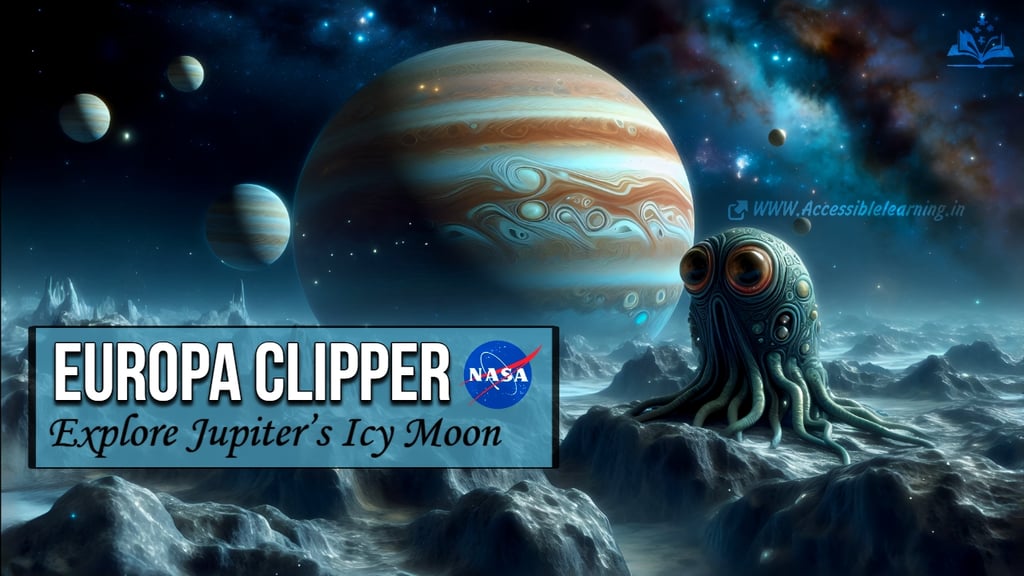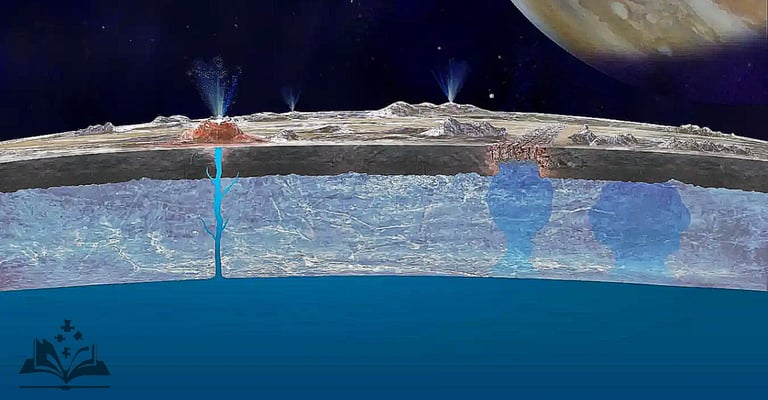
Europa Clipper: NASA’s Groundbreaking Mission to Explore Jupiter’s Icy Moon
Discover NASA’s Europa Clipper mission, set to explore Jupiter’s icy moon Europa. Learn about its objectives, scientific instruments, journey timeline, and potential for discovering extraterrestrial life.
SPACE MISSIONISRO/NASAEDUCATION/KNOWLEDGESPACE/TECH
Sachin K Chaurasiya
2/19/20256 min read


Europa Clipper is NASA’s upcoming interplanetary mission designed to explore Europa, one of Jupiter’s largest moons. Scientists have long been intrigued by Europa because of its potential to harbor extraterrestrial life. The spacecraft will investigate the moon’s icy shell, subsurface ocean, and overall habitability. Expected to launch in October 2024, Europa Clipper will embark on a journey that could redefine our understanding of life beyond Earth.
Why Europa? The Search for Alien Life
Europa is considered one of the most promising candidates for extraterrestrial life within our solar system. Beneath its thick ice crust lies a vast ocean that contains more than twice the water of Earth’s oceans combined. Scientists believe this ocean may contain the necessary conditions for life, including liquid water, essential chemicals, and an energy source.
Key reasons why Europa is fascinating for scientists:
Subsurface Ocean: Hubble Space Telescope observations suggest the presence of water plumes, hinting at active geological processes.
Chemical Composition: Spectroscopic analysis shows an abundance of oxygen, salts, and organic molecules.
Energy Source: Tidal forces from Jupiter generate internal heat, which could drive hydrothermal activity.
Potential for Hydrothermal Vents: Similar to Earth's deep-sea vents, Europa's ocean floor may have active hydrothermal systems that could support life.
Presence of Radiation-Processed Compounds: Interaction with Jupiter's radiation could create complex organic molecules that, if transported to the ocean, may contribute to prebiotic chemistry.
Europa Clipper’s Mission Objectives
The Europa Clipper mission is designed to conduct detailed reconnaissance of Europa’s surface and subsurface. It aims to answer fundamental questions about the moon’s potential habitability by:
Characterizing the Ice Shell and Ocean
Europa’s icy crust is thought to be tens of kilometers thick, but its exact structure remains unknown. Clipper will use radar instruments to probe the ice and map potential water pockets beneath the surface. This will help determine whether the ice shell allows material exchange between the surface and the ocean, which is crucial for habitability.
Analyzing Surface Composition
Spectrometers aboard the spacecraft will analyze the moon’s surface chemistry, detecting compounds such as salts, organics, and volatile substances that may indicate the presence of life-friendly environments. The presence of sulfur compounds and potential carbon-based molecules will be particularly significant.
Measuring Surface Geology
Clipper will examine Europa’s chaotic terrain, ridges, and cracks to understand the geological processes shaping the moon’s ice shell. This includes studying tectonic activity and possible recent cryovolcanic eruptions that could transport oceanic material to the surface.
Assessing Habitability
The mission will investigate the thickness of the ice shell and the potential exchange of materials between the surface and subsurface ocean, crucial for understanding whether Europa’s ocean could support microbial life.
Europa Clipper’s Scientific Instruments
The spacecraft is equipped with cutting-edge instruments designed for high-precision measurements. Some of the most notable ones include:
Europa Thermal Emission Imaging System (E-THEMIS): Captures heat signatures on the surface, identifying regions with possible subsurface water movement.
Mapping Imaging Spectrometer for Europa (MISE): Determines the composition of the surface materials, including organics and salts.
Europa Imaging System (EIS): Provides high-resolution images of Europa’s terrain, enabling detailed geological mapping.
Radar for Europa Assessment and Sounding: Ocean to Near-surface (REASON): Penetrates the ice shell to detect subsurface structures, including potential liquid water reservoirs.
Plasma Instrument for Magnetic Sounding (PIMS): Measures the moon’s magnetic field to infer ocean properties such as salinity and depth.
SUrface Dust Mass Analyzer (SUDA): Studies particles ejected from Europa’s surface and plumes to analyze their composition.
Ultraviolet Spectrograph (UVS): Detects water vapor plumes and analyzes their molecular composition.
Mass Spectrometer for Planetary Exploration (MASPEX): Measures the composition of gases around Europa to determine if biologically relevant molecules are present.


Mission Timeline and Journey
The Europa Clipper will launch aboard a Falcon Heavy rocket in October 2024. The spacecraft will take about six years to reach Jupiter’s orbit, arriving in 2030. Instead of orbiting Europa directly, Clipper will conduct a series of close flybys (around 50 planned) to gather maximum data while minimizing radiation exposure from Jupiter.
Key Mission Phases
Launch (2024): Lift-off from Kennedy Space Center.
Cruise (2024-2030): Journey through deep space with gravity assists from Mars and Earth.
Jupiter System Arrival (2030): Insertion into a Jupiter-centric orbit.
Science Operations (2030-2035): Conducting flybys and collecting data.
End of Mission (Mid-2030s): Potentially deorbiting or repurposing for future studies.
How Europa Clipper Differs from Past Missions
While previous missions like Galileo (1995-2003) provided crucial insights into Europa, Europa Clipper is designed with advanced technology for deeper exploration. Unlike ESA’s Jupiter Icy Moons Explorer (JUICE), which will focus more on Ganymede, Europa Clipper is exclusively dedicated to Europa’s habitability. Moreover, it will conduct more flybys than Galileo, providing a more comprehensive dataset.


Potential for Discovering Life
Although Europa Clipper won’t directly search for life, it will provide essential data that could pave the way for a future landed mission. If evidence of biological activity is detected, Europa could become the prime focus for astrobiology.
Key possibilities include:
Detection of Biosignatures: The presence of complex organic molecules in surface materials or plumes could indicate life-related chemistry.
Evidence of Subsurface Hydrothermal Vents: Similar to Earth's deep-sea vents, these could be potential habitats for microbial life.
Confirmation of Liquid Water Near the Surface: Would increase the likelihood of life existing within Europa’s ocean.
FAQ's
When will Europa Clipper launch?
The mission is scheduled to launch in October 2024 aboard a SpaceX Falcon Heavy rocket from Kennedy Space Center, Florida.
How long will it take to reach Europa?
Europa Clipper will take about six years to reach Jupiter’s orbit, arriving in 2030.
Why is Europa considered a good candidate for extraterrestrial life?
Europa has a subsurface ocean beneath its icy crust, containing more water than all of Earth’s oceans combined. It also has an energy source from tidal heating and essential chemical ingredients, making it one of the most promising locations for alien life in our solar system.
What are the main scientific goals of the mission?
The primary objectives of Europa Clipper include:
Studying Europa’s ice shell thickness and ocean properties
Analyzing the surface for organic compounds and biosignatures
Investigating water plumes for potential life-related chemistry
Mapping the geological features and tectonic activity
Measuring radiation effects on Europa’s surface
Will Europa Clipper land on the moon’s surface?
No, Europa Clipper is a flyby mission, meaning it will conduct multiple close passes (~50 flybys) of Europa instead of landing. However, a future lander mission may be considered if Clipper finds strong evidence of habitability.
How close will Europa Clipper get to Europa’s surface?
The spacecraft will fly as close as 25 km (15 miles) above Europa’s surface, allowing high-resolution imaging and data collection.
What scientific instruments will the spacecraft carry?
Europa Clipper is equipped with nine advanced scientific instruments, including:
Radar for Europa Assessment and Sounding: Ocean to Near-surface (REASON)—Probes the ice shell and detects subsurface water
Plasma Instrument for Magnetic Sounding (PIMS)—Measures Europa’s magnetic field to estimate ocean depth and salinity
Mapping Imaging Spectrometer for Europa (MISE)—Identifies organic molecules and salts on the surface
Mass Spectrometer for Planetary Exploration (MASPEX)—Analyzes atmospheric gases for biosignatures
Europa Imaging System (EIS)—Provides high-resolution surface images
How does Europa Clipper differ from previous missions?
Europa Clipper is dedicated to studying Europa’s habitability, unlike Galileo (1995-2003), which provided initial data, or Juno (2016-present), which mainly studies Jupiter. Unlike ESA’s JUICE mission, which focuses on Ganymede, Clipper is exclusively designed for Europa.
Can Europa Clipper directly detect life?
No, the mission is not designed to detect life directly. However, it will search for biosignatures (organic compounds, water plumes, and chemical markers) that indicate whether Europa’s ocean could support life.
What happens after the mission ends?
After its science operations (2030-2035), Europa Clipper may either be
Deorbited into Jupiter or another moon to prevent contamination
Repurposed for further studies if enough fuel remains
Will humans ever explore Europa?
A crewed mission to Europa is not currently planned due to extreme radiation and harsh conditions. However, if Europa Clipper finds strong evidence of life-friendly conditions, a future robotic lander may be developed.
How will Europa Clipper be protected from Jupiter’s radiation?
The spacecraft will have a radiation-shielded vault to protect its electronics from Jupiter’s intense radiation environment.
How can the public follow the mission?
You can track Europa Clipper’s progress through:
NASA’s official website
Social media updates (@NASASolarSystem on Twitter, NASA YouTube, etc.)
Live mission coverage on NASA TV


Europa Clipper is a groundbreaking mission that could transform our understanding of one of the solar system’s most enigmatic moons. By analyzing Europa’s ice shell, ocean, and geological activity, this mission will bring us closer to answering one of humanity’s biggest questions: Are we alone in the universe?
With a launch set for 2024, the world eagerly awaits the discoveries that could emerge from this daring exploration of Jupiter’s frozen, mysterious moon.
Subscribe To Our Newsletter
All © Copyright reserved by Accessible-Learning Hub
| Terms & Conditions
Knowledge is power. Learn with Us. 📚


